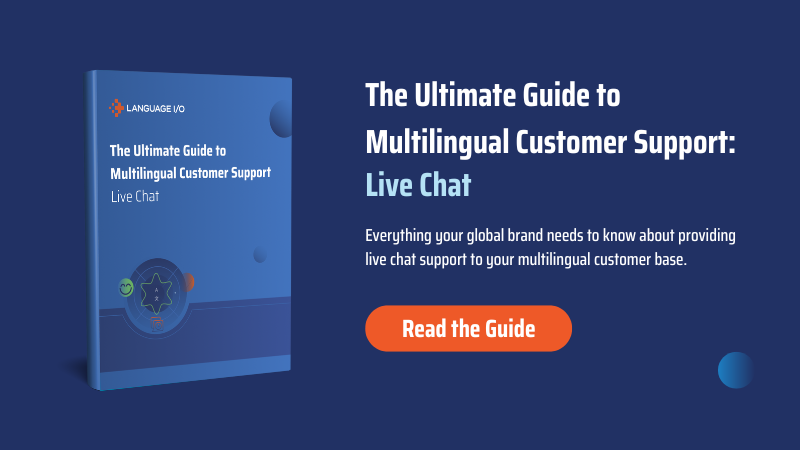The popularity of live chat for customer service resolution has grown significantly in recent years in response to consumer demand for live interaction with the brands they use. According to 2021 statistics, 67% of B2C companies use live chat for customer service. This number is only expected to rise: live chat software sales are expected to reach $977 million by 2023.
Companies are implementing live chat in response to the overwhelming demand from consumers for real-time, personalized customer support. A report from Kayako notes that just over half (52%) of consumers are more likely to remain loyal to a company that offers live chat support. Meanwhile, 79% of businesses report that offering live chat has had a demonstrable positive effect on sales, revenue, and customer loyalty.
Live chat is a great way for businesses to deliver positive customer experiences, as it enables organizations to meet customer demand for instant communication and service. Chatting with a live, human agent can provide quick answers to otherwise challenging questions, and offers customers the option to communicate with brands online—their preferred medium—while still interacting with a real person.
But what happens when incoming chats are in a language the customer service agent doesn’t understand? With the global nature of today’s online marketplace, businesses must be able to communicate in the preferred language of their customers. In many cases, companies turn to free solutions such as Google Translate in order to communicate with their global customers. But using Google Translate for customer service is a decision that comes with a number of key considerations businesses must keep in mind.
Using Google Translate for Live Chat Translation
At first glance, Google Translate may appear to check the boxes that businesses need to help their customer service agents communicate effectively with global customers. As a free, widely accessible product, Google Translate is able to provide fast translations at no cost to organizations. It also supports more than 100 languages and can be accessed via multiple devices, including desktop computers—which agents are likely using while communicating with customers.
But though it’s versatile and easy to use, there are a number of reasons that Google Translate isn’t enough for brands that rely on translations to manage and operate their customer service chat channels on a global level.
The Ultimate Guide to Multilingual Customer Support: Live Chat
Download this guide to learn about the various approaches to delivering multilingual support over chat channels and, most importantly, identify the right solution for your organization.
Why Google Translate Isn’t Enough for Translating Customer Service Chats
Communicating effectively is a key part of maintaining and growing a loyal customer base. For global brands, this means providing in-language support regardless of the language spoken by the agents representing the brand. In order to elevate customer service chat channels and deliver an optimal experience, companies need seamless and accurate translation solutions that go beyond Google Translate.
So why does Google Translate fail to meet the needs of brands looking to provide multilingual live chat support? Here are the main reasons:
Inefficiencies
Using Google Translate to translate each and every incoming and outgoing live chat is a cumbersome process for agents to carry out, particularly when agents are trying to resolve issues quickly. Copying and pasting content in and out of Google Translate requires agents to constantly swap between the CRM or live chat tool they are using and the Google Translate interface. So much manual switching is likely to lead to human error—such as pasting a message in the wrong chat window—or create so much friction in the process that it reduces agent satisfaction.
Translation Quality
Google Translate’s quality has made great strides since it was first introduced, to the point that it’s one of the best machine translation engines on the market. However, using it on its own is unlikely to produce the quality of translations that brands need in order to properly communicate with and support customers.
The primary reason for this is that Google Translate doesn’t take into account key contextual considerations such as brand names. Take the following translation as an example:
As humans, we understand the ‘apple pencil’ refers to the branded Apple Pencil, but Google Translate doesn’t—it instead translates the word “apple” into “pomme,” which is the French word for the fruit in question. While Apple products may be ubiquitous enough that non-English speakers might still understand what is being said, brands that aren’t household names will suffer from Google’s tendency to mistranslate such terms.
Security
An often overlooked issue with Google Translate, among other free tools, is security. The free version of Google Translate stores text and other content that users submit for translation. All content submitted is subject to Google’s terms of service, meaning that it can be stored and analyzed. If a customer service or other business agent enters customer personally identifiable information (PII) or confidential company information into the Google Translate tool, there could be significant security implications, including the risk of that data being unearthed in a breach.
Customers who want to resolve an issue quickly may be likely to share all sorts of PII, from their full name to their email address to even their credit card information or physical address. Agents seeking to get them the quick answers they need don’t have the time to manually strip each message of PII, which will result in this sensitive information being stored in Google’s database.
A Better Alternative to Google Translate
If Google Translate doesn’t fit the bill, then what can brands do to deliver real-time translations of chat messages? A better alternative to Google Translate is to implement a live translation software solution that offers fast and accurate translations while keeping customer and company information secure. Such advanced software solutions are seamless, cost-effective, and scalable, as they often eliminate or significantly reduce the need to hire native speakers to keep up with customer service demands.
At Language I/O, our live chat translation software aggregates the world’s leading machine translation engines to provide accurate, real-time translations of chats in more than 150+ languages, all within the CRM or live chat platform that agents already use to communicate with customers. We also adhere to the most stringent industry security standards including ISO 27001 and GDPR, and we encrypt all PII prior to translating it so that customer data is always protected.

A free tool such as Google Translate may be appealing at first. But forward-thinking businesses that are looking to elevate their customers’ experiences find that dedicated live chat translation software is the solution to deliver accurate, localized, and personalized customer service with each interaction.
For more information about how our live chat translation software can boost customer satisfaction while reducing multilingual support costs, reach out to us or request a personalized demo.



